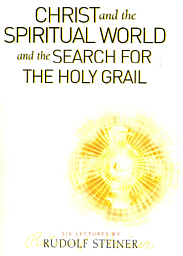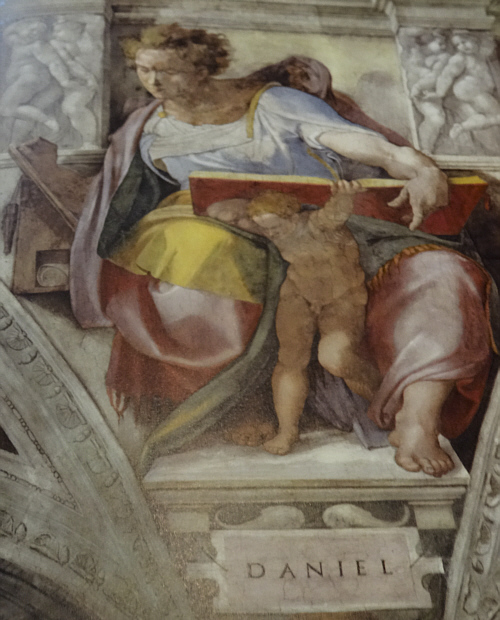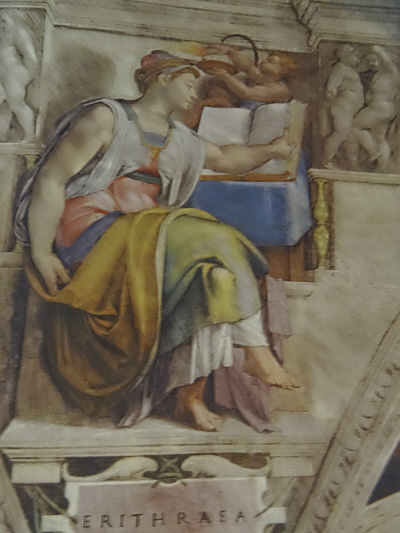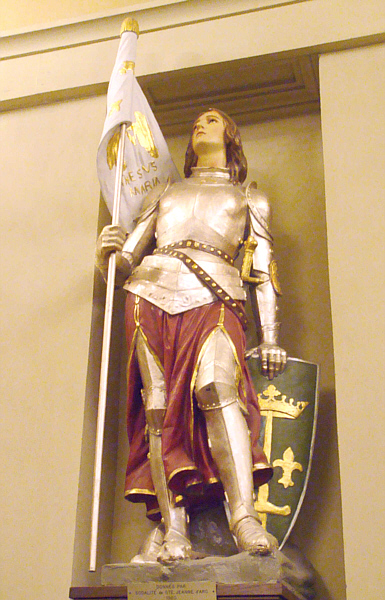How could the ancient Indian Rishis have
understood the Christ Being? They had none of the thoughts and ideas of the later Greeks like
Plato and Aristotle. It could only have come to them as inspirations via their astral bodies,
essentially a gift from the spiritual world.
Later in Plato's time, ideas and concepts came from the spiritual world through the
medium of thoughts which were laid hold of and expounded via the Ego instead of the astral
body. This new ability existed harmoniously alongside the older chaotic prophecies of the
Sibyls which offered only warped views of the spiritual world. The Ego was waxing as a
stronger influence and the astral body was waning.
So, as my old friend Bagley used to ask after some long discussion about software design,
"What does all this mean?" It meant that humankind was being readied for the most significant
event in the history of the world, the Mystery of Golgotha, when the great Christ Being
completed His journey and filled the Earth aura with His Spirit. Lacking this the Sibylline
forces would have wreaked havoc upon humankind by maintaining their forces right up to the
present time. This did not happen.
Steiner includes Paul as a fifth writer of the Gospels, one who indicated how the Christ
won the battle against the Sibyls. Even though Paul couldn't find the exact words to express
what was going on with this battle, somehow his message came through between his words.
Paul's words sounded out notes of the Prophets of old and the words of Sibyls spoken out from
the elements of the Earth.
One of amazing things about Paul was that the regions he traveled to and brought the
message, the Good News of Christ, were all regions in which olive trees grew. I had
encountered this observation elsewhere in Steiner, but here he offers an explanation for this
otherwise strange situation. One must understand the power of elementals of the Earth and
how it flowed as a good force through Paul.
Steiner next talked about Paul in Lecture 4, a day later than he planned; instead, on the
next day, he focused on the three sacrifices of Christ which preceded His ultimate sacrifice on
the Cross. The best exposition of these sacrifices outside of Lecture 3 can be found in
Approaching the Mystery of Golgotha, GA#152 whose lectures are contemporary with,
coming before and after, this lecture series(5). What this lecture reveals is that these sacrifices
filled the spiritual Being who was later to become the Nathan Jesus-child.
The First Sacrifice moderated the human sensory system. The spiritual Being heard a cry
of distress from the human sensory system, which was being beset by Lucifer and Ahriman,
and unless this Being intervened, the human senses would have continually bounced from one
extreme of bliss to intense pain without end; some moderation was needed and this Being
provided it.
[page 56, 57] So it was that in the spiritual world the Being who later
became the Nathan Jesus-child was permeated by the Christ Being, and
then brought about a change in the cosmic forces which were streaming
in to build up the human senses. These senses were changed in such a way
that instead of being mere organs of sympathy and antipathy, they became
organs that human beings could use, and so could look with wisdom at all
the nuances of sense-perception. Very differently would the cosmic forces
have flowed into mankind if this event, far back in the Lemurian Age, had
not taken place in the spiritual worlds. This Being who appeared as the
Nathan Jesus-child was then still living (if I may use the phrase) in the
Sun-sphere, and because he listened to the human cry of distress, he
experienced something which made it possible for him to be permeated by
the very Spirit of the Sun, so that the activity of the Sun was modified in
such a way that the human sense-organs, which derive essentially from
solar activity, did not become organs of mere sympathy and antipathy.
The planetary forces worked on the vital organs of humankind without the direct influence
of the Sun, and unabated, they would have created intense greed and loathing. The Second
Sacrifice came from the Christ Being whose origin was the Sun and moderated these extreme
behaviors in the vital organs by entering the Nathan Jesus-child Being.
[page 58, 59] So again something had to happen in the spiritual worlds in
order that this destructive activity should not enter into human life. And
this same Being, who later appeared as the Nathan Jesus-child and who
(as we have explained) dwelt in earlier times on the Sun and was there
permeated by the Christ Being, the sublime Sun-Spirit — this Being went
from planet to planet, touched in his innermost nature by the fact that
human evolution could go no further, as things were. And this experience
affected him so strongly, while he was assuming a form of body on the
different planets, that at a certain time during the Atlantean evolution the
Spirit of Christ permeated him again. And through what was now brought
about by the permeation of this Being by the Christ Spirit, it became
possible for moderation to be implanted in the vital organs of man. In the
same way that wisdom had been given to the sense-organs, so moderation
was now bestowed on the vital organs. Thus it came about that when a
man breathed in a particular place, he was not impelled to suck in the air
greedily, or to recoil with loathing from the air in another place. That was
the deed accomplished in the spiritual worlds through a further
permeation of the Nathan Jesus-child by the Christ Being, the high
Sun-Spirit.
These first two Sacrifices moderated our senses and vital organs, but our soul-organs of
thinking, feeling, and willing were not yet moderated. One can understand the effect of this
lack of moderation by reading the Iliad and Odyssey, those Homeric epics from the time before
the invention of writing. We can view the excess of will in Agamemnon who stole Achilles'
war prize, the lovely Briseis, causing Achilles to withdraw from the Battle of Troy. Many
excesses of thinking, feeling, and willing are portrayed in these pre-Mystery-of-Golgotha
epics(6).
Our three soul organs originating from the planets needed to be harmonized by the actions
of the Sun, Moon, and Earth. This was accomplished by the same Nathan Jesus-child Being
during the Third Sacrifice by the Christ Being.
[page 60, 61] Help for these soul-forces had to be provided from the
spiritual world. And now the soul of that Being who later became the
Nathan Jesus-child assumed a cosmic form such that his life was in a sense
neither on the Moon nor on the Sun, but as though it encircled the Earth
and felt a dependence on the influences of Sun, Moon and Earth at the
same time. The Earth influences came to him from below; the Sun and
Moon influences from above. Clairvoyant observation really sees this
Being, in the spring-time of his evolution — if I may use that phrase — in
the same sphere as that in which the Moon goes round the Earth. Hence
I cannot say exactly that the Moon influence came to him from above, but
rather that it came to him from the place where he was, this pre-earthly
Jesus-Being. Again there rose to him a cry of distress, a cry that told of
what human thinking, feeling and willing were on the way to becoming;
and he sought to experience completely in his own inner being this tragedy
of human evolution. Thereby he called to himself the high Sun-Spirit, who
now for the third time descended upon him, permeating him. So in the
cosmic height, beyond the Earth, there was a third permeation of this
Nathan Jesus-child by the high Sun-Spirit whom we call the Christ.
There is a wealth of information in pages 62 through 69 answering questions about a
plethora of subjects. Why was the Sun and the Ego so important to Zarathustra in the Persian
(second cultural) epoch? Why did astrology arrive in the Egypto-Chaldean (third cultural)
epoch? Why did the gods arrive during the Greco-Roman (fourth cultural) epoch? How was
Apollo connected with St. George? (Both shot arrows into a dragon, Apollo figuratively, St.
George literally.) How did the Greek and later Roman gods get their names from the various
planets?
But we continue on with the Fourth Sacrifice of Christ in the Mystery of Golgotha, but
for which we humans would have never received our unique identity, the name that each one
of us can call our "I", our Ego, our eternal spirit. When each one of us say "I exist", we
unconsciously acknowledge the gift of the Fourth Sacrifice.
[page 70] We have seen this Being pass through three stages of evolution,
and then the Healer, whom Apollo reflected, was born on Earth and men
called him Jesus, which in our language means "He who heals through
God". He is the Nathan Jesus-child, the one who heals through God,
Jehoschua-Jesus.
Now, at this fourth stage, this Being made himself ripe to be
enfilled with the Christ Being, with the 'I'. This came to pass through the
Mystery of Golgotha. For if this Mystery had not been enacted — if the
Being whom we have followed through cosmic ages had not given
embodiment to the Christ — then in the course of later time human souls
would not have found bodies in which the Ego-force could come to
necessary expression on Earth. The Ego had been brought to its highest
stage in Zarathustra. The souls who had taken part in the evolution of the
Ego would never have found earthly bodies suitable for its further
development if the Mystery of Golgotha had not come to pass.
There you have it: you and I today live and enjoy the gift of the Four Sacrifices, each one
having brought to us humans a new harmony. Let us give thanks during the Christmas season
each year for these marvelous gifts and use them in our lives to help ourselves and others live
to the fullest.
[page70, 71] We have now seen the four stages of harmonization: the
harmonizing of sense-perception, of the life-organs, of thinking, feeling
and willing, and the harmonization in the Ego, this last through the
Mystery of Golgotha. You have the connections between the Being who
was born as the Nathan Jesus-child and the Christ Being, and the way in
which this was prepared. It is now possible, through that which it is
permissible to reveal in true Anthroposophy, to understand this kind of
growing together, belonging together, of the Christ Being and the human
nature of Jesus. This is possible for us. And a healthy development of
spiritual life in the future will depend on this — on it becoming possible
for more and more people to grasp that which could not be grasped by the
thoughts and ideas of the epoch in which the Mystery of Golgotha was
fulfilled.
Through Lectures 4 and 5 Steiner weaves a wonderful and mysterious tale of the search
for the Grail, the Holy Vessel upon which stands the name Parsifal. After much seeking in the
spiritual world and in exoteric sources, Steiner glimpses the New Moon in the Old Moon's
arms and finds the name Parsifal. To understand the following passage, you will need an
explication of these two expressions: ganganda greida and viaticum. Page 144 contains a
detailed discussion of ganganda greida, which can be summarized as "provisions of
nourishment for a journey." The word viaticum meant specifically the provision for the journey
from this life to the next, as it is the name of the consecrated host administered by a priest to
someone who is dying.
[page 111] Where, then, is the Grail, which to-day must he found in such
a way that the name of Parsifal stands upon it? Where can it be found?
Now in the course of my researches it had been shown to me that the name
— that is the first thing — must be sought for in the stellar script. And
then, on a day which I must regard as specially significant for me, I was
shown where the gold-gleaming vessel in its reality is to be found, so that
through it — through its symbolical expression in the stellar script — we
are led to the secret of the Grail. And then I saw in the stellar script
something that anyone can see — only he will not immediately discern the
secret. For one day, while I was following with inner sight the
gold-gleaming sickle of the moon, as it appeared in the heavens, with the
dark moon like a great disc dimly visible within it . . . so that with physical
sight one saw the gold-gleaming moon — ganganda greida, the journeying
viaticum — and within it the large Host, the dark disc. This is not to be
seen if one merely glances superficially at the moon, but it is evident if one
looks closely — and there, in wonderful letters of the occult script, was
the name Parsifal!
That, to begin with, was the stellar script. For in fact, if this
reading of the stellar script is seen in the right light, it yields for our hearts
and minds something — though perhaps not all — of the Parsifal secret,
the secret of the Holy Grail.
If we understand that Easter is designated each year as the first Sunday after the first Full
Moon after the spring (or vernal) equinox, we can understand why Easter is such a complicated
movable feast. Its date is chosen so that one can witness on Good Friday, in accordance with
the Parsifal story, the renewal of the Host as it sinks into the Holy Grail to be renewed. (Page
115)
Can we point to the influence of Sybils in the course of history in a more modern time than
ancient Greece and Rome? Yes, definitely. In the early fifteenth century Joan, a young peasant
girl of Arc, spoke as a Sibyl of the urgent need for an ordained king of France. No one would
listen to her at first, so she found a way to take up arms, collect an army around her, and
overcome the British force at Orleans. This defeat drove the British out of France and allowed
the Dauphin to become a rightfully ordained King of France. Without this 19-year-old
woman's courageous efforts, there might be today no country known as France, no French
language(7). I first encountered this understanding when in 2008 I was studying the Occult
History lectures of Rudolf Steiner, which he refers to in this next passage.
[page 119] I want to touch on a manifestation to which I called attention
three years ago — three years almost to the day — the transformation of
a Sibyl under the influence of the Christ Impulse. In the lectures printed
under the title of Occult History, I referred to the appearance of the Maid
of Orleans. I pointed out how events of the greatest importance for the
destiny of Europe in the subsequent era flowed from what the Maid of
Orleans accomplished under the influence of her inspirations, fully
permeated by the Christ Impulse, beginning in the autumn of 1428. From
external history one can indeed learn that the destiny of Europe would
have been very different if the Maid of Orleans had not appeared when
she did, and only an entirely obsessed materialist, such as Anatole France,
can deny that something mysterious came into history at that time.
Indeed, the destiny of many countries outside of Europe would have been different.
Thousands of place names in North America would be drastically different today but for Joan
saving France from absorption by Britain, especially in Quebec and South Louisiana. It pains me to imagine the French Quarter of New Orleans being named English Place! Or Louisiana being named Henriana. Or New Orleans being named New Harrogate.
Clearly Steiner saw Joan of Arc, the Maid of Orleans, as a modern Sybil.
[page 120] I will not repeat here what can be read in history-books;
anyone who has listened to these lectures can see that something like a
modem Sibyl emerged in the Maid of Orleans. It was the time — the
fifteenth century — when the fifth post-Atlantean (our current cultural) epoch begins; a time
when the Christ Impulse had to emerge more and more from the
subconscious depths of the soul. We can see in what a gentle, tender form,
imbued with the noblest qualities of the human soul, the Sibylline power
of the Maid of Orleans is revealed.
But what might a man of Joan's time have written about her? Steiner shares with us the
words Lord Percival, a man in the entourage of the King whom the Maid of Orleans liberated,
wrote to the Duke of Milan carefully describing her achievements:










